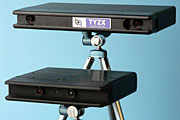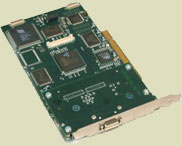Device Profile: Tyzx DeepSea G2 3D vision system
Sep 18, 2006 — by LinuxDevices Staff — from the LinuxDevices Archive — 11 views Computer vision specialist Tyzx is shipping a relatively low-cost, standalone, Linux-based stereo 3D vision system targeting high-volume commercial and defense robots, automobiles, and person-tracking security systems. The DeepSea G2 can provide real-time 3D vision processing where traditional workstations can't go, the company says.
Computer vision specialist Tyzx is shipping a relatively low-cost, standalone, Linux-based stereo 3D vision system targeting high-volume commercial and defense robots, automobiles, and person-tracking security systems. The DeepSea G2 can provide real-time 3D vision processing where traditional workstations can't go, the company says.

G2's with 6cm and 22cm “baselines”
Tyzx claims its 3D stereo vision technology to be based on 15 years of research at Harvard, MIT, Stanford, and Interval Research. The company says its key partners, customers, and product testers include NASA, Unisys, and Takata Group.
 Tyzx previously offered a PCI-based capture card (pictured at right) that uses LVDS (low-voltage differential signaling) to interface with stereo vision cameras. The G2 is its first “turn-key” 3D stereo vision system, it says. The G2 is compatible with the same “SEER” C++ library and software development kit previously available for the PCI-card version.
Tyzx previously offered a PCI-based capture card (pictured at right) that uses LVDS (low-voltage differential signaling) to interface with stereo vision cameras. The G2 is its first “turn-key” 3D stereo vision system, it says. The G2 is compatible with the same “SEER” C++ library and software development kit previously available for the PCI-card version.
Two eyes better than one?
Tyzx says its DeepSea G2 outperforms monocular lidar/radar (light/radar detection and ranging) systems, in terms of color, field of view, resolution, and range accuracy. The product is especially suited to variable lighting conditions, according to the company.
The G2's imaging system is based on a pair of inexpensive Micron MT9V022 CMOS imagers, set either 6cm or 22cm apart (the “baseline”), with resultant respective fields-of-view of 70 degrees or 44 degrees.
Within its range of vision, the “22cm baseline” G2 can spatially locate objects that are between 8.9 and 115 feet (2.7 to 35 meters) away, with rangefinder accuracy varying from 2.8 inches (at 8.9 feet) to 39 inches (at 115 feet), Tyzx claims.
The G2 can interface with other computers via TCP/IP and “standard Linux utilities” or a bundled “ProjectionSpace” application that dynamically creates a 2D map of objects within the range of vision. Alternatively, user-developed applications can interface with the device via programmable I/O lines and serial ports that connect to the Blackfin DSP.
The G2 measures 1.5 x 11.1 x 6.7 inches (3.8 x 28.3 x 16.9cm). It has a standard threaded tripod mount, and can be powered by PoE (power-over-Ethernet) or a 12-volt power brick.
What's under the hood?
The G2 appears to have no less than four processors:
- Linux runs on an unspecified PowerPC processor
- A “DeepSea II” ASIC handles stereo image processing
- An unspecified FPGA (field-programmable gate array) is said to “implement new Tyzx vision primitivies”
- An ADI BlackFin (DSP) helps the PPC/Linux processor host Tyzx's “SEER” software API and user applications
Tyzx explains, “The G2 transforms incoming imager data into 3D object maps, with the use of vision primitives implemented directly in hardware. [This frees] the Linux CPU and DSP to host the Tyzx SEER software API and user applications.”
Tyzx CEO Ron Buck stated, “Tyzx' G2 can be used to create high performance, small format, low power 3D vision systems that can be easily deployed in the real world.”
Strategy Analytics VP Neena Buck stated, “Monocular camera systems have dominated commercial markets due to their lower cost. Designers can now consider implementing 3D vision systems as alternatives to monocular camera systems.”
Availability
The DeepSea G2 Vision system is available now, priced at $5K in low volumes.
This article was originally published on LinuxDevices.com and has been donated to the open source community by QuinStreet Inc. Please visit LinuxToday.com for up-to-date news and articles about Linux and open source.